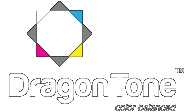D-Tone 5040K effectively sets up a systematic methodology for comparing neutral tones created with Black, and a combination of Cyan, Yellow, and Magenta. By creating an easy method for comparing the perfect neutral tone between Black and a neutral tone created by a combination of Cyan, Magenta, and Yellow in the four-colour printing process, D-Tone 5040K provides a consistent system for establishing perfect tonality in the CMYK mix.
The D-Tone 5040K system consists of a revolutionary colour quality control bar, which structures any four-colour printing environment to output results made up of a pre-determined percentage of Black, and a combination of Cyan, Magenta and Yellow. The innovative arrangement of the comparative results mean that any differences in colour tonality can be easily distinguished by the human eye, allowing any technician on the printing floor to establish the condition of the colour adjustment.
This means that subtle variables within the printing process, including variables in ink quality, their application on the paper, printing plate pressure, plate conditions, and the age and condition of the press itself, can be highlighted, and then compensated for, to achieve the perfect neutral tone.
Once the printing press is set up to produce a consistent neutral tone with Black and a combination of CYM – when both neutral tones are indistinguishable from each other, then the printing press is set up to produce the same results – every time.
The system goes beyond simply just producing the perfect tonality on a single press, but also enables a consistent result across multiple printing presses – as long as they are set up using the D-Tone 5040K system.
More importantly, the innovation behind D-Tone 5040K enables easy comparisons of the neutral tones created with Black against the neutral tone created by the CMY combination, making it easy to use by any technician without extensive training, or additional hardware.
While commercial printers can achieve near-perfect set up of their printing press with D-Tone 5040K, perfectly set up presses don't always produce the results that customers want. Today, digital files are created on computers and initial proofs are often produced on consumer-grade printers – both processes of which can have varying colour settings, producing results with different attributes. The result can be files that appear to be perfect to the designer or publisher's eye, but are actually far from tonally neutral. In these cases, the perfect reproduction, when outputted on a D-Tone 5040K-enabled press, might be different from what the customer actually had in mind.
There are two ways to solve this problem. Either the customer takes the files back and then correctly adjusts the colour for commercial printing, or the commercial printer estimates the adjustment required for the colour mix and then outputs the customer's desired print. While this method can be apply to meet customer expectations, it is almost impossible to repeat for future editions.
In these cases, D-Tone 5040K is also applicable, not by establishing the perfect tone for each press, but by highlighting the difference that each customer wants. Due to the innovative layout of the colour coding system of D-Tone 5040K, printers can still establish consistency of prints by comparing the variance that each customer wants for their print. Each print is then printed to a standardised tonal profile – although this is no longer the perfect neutral tone.

